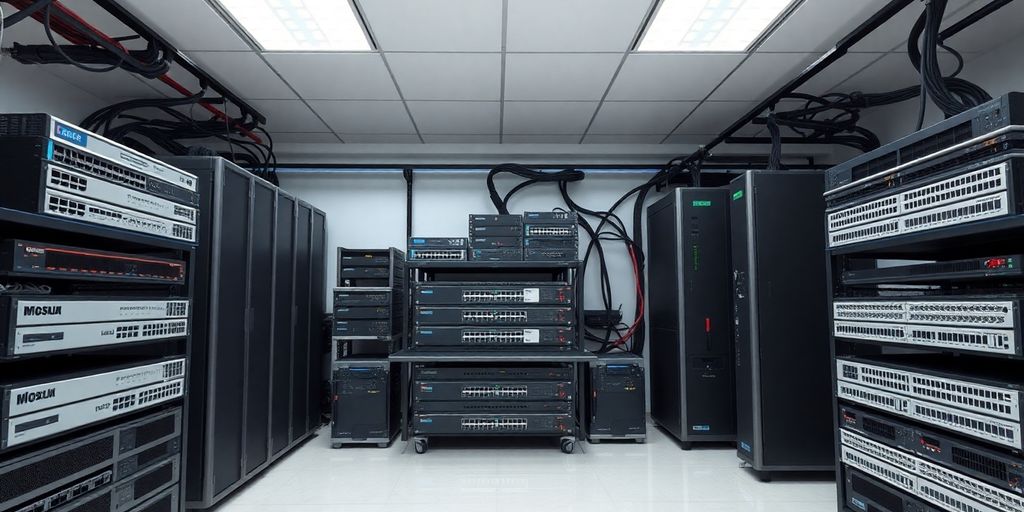In 2025, security is getting a major upgrade with new access control equipment. Forget the old keycards and PIN codes—this new wave of technology is all about making things smarter and safer. From using your phone as a key to systems that think for themselves, the future of access control is here, and it’s pretty exciting. This article takes a look at some of the coolest innovations you can expect to see.
Key Takeaways
- Biometric systems are moving past fingerprints to include facial, iris, and vein recognition for tighter security.
- Smartphones are becoming the new keys, with QR codes and Bluetooth making access easier and more secure.
- Cloud-based systems offer centralized control, making it easy to manage security across different locations.
- AI is stepping in to predict and prevent security issues before they happen, making systems smarter.
- IoT devices are linking up with access control for a more connected and responsive security setup.
Biometric Authentication: The Future of Access Control

Facial Recognition: Beyond the Basics
Facial recognition is more than just matching a face to a database. In 2025, it’s about precision and speed. Systems are now designed to recognize subtle changes in appearance, like wearing glasses or growing a beard, ensuring that access is granted only to the right individuals. This technology has become essential in high-security environments, where every second counts and mistakes can’t be afforded. Plus, with AI advancements, these systems can now process thousands of faces in real-time without a hitch.
Iris and Vein Scanning: Cutting-Edge Security
Iris and vein scanning are the new kids on the block in biometric security. While iris scanning uses unique patterns in the eye, vein scanning looks at the unique layout of veins in your hand. These methods are nearly impossible to fake, providing a level of security that’s hard to beat. Imagine walking into your office and having your identity confirmed by just a glance or a wave of your hand. It’s like something out of a sci-fi movie but very real and practical today.
AI Enhancements in Biometric Systems
AI is not just a buzzword; it’s transforming biometrics. With AI, biometric systems are learning and adapting, becoming smarter every day. They can now predict potential security breaches by recognizing unusual patterns or behaviors. For instance, if someone tries to access a restricted area repeatedly and fails, the system can alert security before a breach happens. This kind of proactive security is what sets modern systems apart, making them indispensable in today’s world.
As biometric technologies expand their role in 2024, including age assurance in functional markets, their importance in the digital landscape grows, highlighting their potential in access control.
Mobile-Enabled Access: Transforming Security with Smartphones
QR Codes and BLE Technology: A New Era
Using your phone as a key is not just a futuristic concept anymore. It’s happening now! QR codes and Bluetooth Low Energy (BLE) are revolutionizing how we think about security. These technologies make it super easy for people to enter secure areas with just a scan or a tap. No more fumbling with keys or cards. It’s quick, it’s efficient, and it’s the future. Plus, they’re flexible enough to adapt as security needs change. This shift is not just about convenience—it’s about ensuring security without the hassle.
Streamlining Visitor Management with Mobile Access
Managing visitors can be a real pain, especially in busy places. But with mobile access, it’s a breeze. Phones can now act as virtual passes, allowing guests to check in and move around without needing a physical badge. This not only speeds up the process but also makes it safer. Imagine not having to worry about lost visitor badges or unauthorized access. It’s all handled through the phone! This system is perfect for offices, events, and any place that sees a lot of foot traffic.
Security and Convenience: The Mobile Advantage
The best part about mobile-enabled access is how it balances security with convenience. Smartphones come with built-in security features like biometrics and encryption, making them a safe choice for access control. And if a phone gets lost, access can be revoked remotely, reducing the risk of unauthorized entry. It’s like having a security guard in your pocket. This approach not only protects sensitive areas but also makes life easier for everyone involved. In 2025, expect mobile access to be the norm rather than the exception.
Cloud-Based Systems: Revolutionizing Access Control Management
Cloud-based systems are changing the way we think about access control. In 2025, these systems are not just about storing data offsite; they are about transforming how security is managed across various locations and in real-time.
Centralized Control Across Multiple Locations
Imagine being able to manage security for all your offices from a single platform. That’s what cloud-based systems offer. They allow businesses to control access across different sites without the need for physical presence. This centralized approach means that whether you’re in New York or Tokyo, you can ensure that security protocols are consistent and up-to-date. This is particularly useful for companies with multiple branches or those planning to expand.
Real-Time Updates and Remote Management
One of the standout features of cloud-based systems is their ability to provide real-time updates. You can instantly know who accessed what and when, and make changes on the fly. This level of remote management offers unmatched flexibility and efficiency. For example, if a security breach occurs, you can lock down access immediately, no matter where you are. This capability is crucial for maintaining security in an increasingly remote and hybrid work environment.
Seamless Integration with Existing Infrastructure
Switching to a cloud-based system doesn’t mean you have to overhaul your current setup. These systems are designed to integrate smoothly with existing infrastructure. This means you can enjoy the benefits of modern technology without the hassle of starting from scratch. Plus, as technology evolves, cloud-based systems can be updated easily, ensuring that your security measures are always cutting-edge.
The shift to cloud-based access control systems is not just a trend; it’s a necessity for businesses aiming to keep up with the fast-paced digital world. As more companies recognize the benefits of centralized management and real-time updates, cloud solutions will become the norm rather than the exception.
For more on key access control trends in 2025, including touchless entry and access technology, check out the latest insights.
AI-Powered Access Control: Intelligent Security Solutions
Predictive Security Measures and Real-Time Alerts
AI is really changing the game in security. It’s not just about keeping people out anymore; it’s about predicting what might happen next. These systems learn over time, picking up on unusual patterns. If someone tries to enter a building at a weird hour, the system will flag it and alert security. This is especially useful for places with a lot of entry points. AI helps catch potential threats before they become real problems.
Data-Driven Insights for Enhanced Safety
Data is everywhere, and AI uses it to make security smarter. By analyzing access logs and other data, AI can spot trends and suggest improvements. This means security isn’t just reactive anymore; it’s proactive. Businesses can use these insights to tighten security and make informed decisions about where to focus their efforts. It’s like having a security consultant working 24/7.
AI-Driven Decision Making in Access Control
AI doesn’t just collect data; it acts on it. When a potential threat is detected, AI systems can decide what to do next. They might lock doors, alert security personnel, or even call the authorities. This quick decision-making process is crucial in emergencies. By automating these responses, AI systems reduce the time it takes to react to threats, which can make all the difference in keeping people safe. AI-powered analytics tools are revolutionizing how security is monitored and managed, making it more effective than ever before.
The future of security is here, and it’s smarter than ever. With AI, businesses can stay one step ahead of potential threats, ensuring a safer environment for everyone.
Integration with IoT Devices: Building a Connected Security Ecosystem

Comprehensive Visibility with IoT Integration
In 2025, the integration of IoT devices with access control systems is transforming the security landscape. By connecting various elements like CCTV cameras, alarm systems, and HVAC controls, businesses can achieve a more comprehensive security ecosystem. This setup offers complete visibility over facilities, ensuring that every corner is monitored and secure. When an unauthorized access attempt is detected, the system can instantly trigger an alarm, send alerts to security staff, or even adjust lighting and temperature settings. This integration brings everything under one roof, enhancing response efficiency and providing a holistic security solution.
Automated Responses to Security Threats
IoT-enabled access control systems allow for real-time monitoring and management of connected devices, creating a responsive and efficient environment. For instance, IoT sensors can automatically adjust HVAC settings based on occupancy data, while access control systems can monitor and manage occupancy levels to ensure safety and energy efficiency. These systems are future-proof, as they can be easily updated and expanded to meet evolving security needs. With automatic software updates and the ability to integrate new technologies, organizations can stay ahead of emerging security threats.
Enhancing Efficiency with IoT-Connected Systems
The rise of smart buildings is a driving force behind the integration of IoT devices with access control systems. In 2025, access control is not just about locking doors—it’s about creating a connected ecosystem that integrates various building systems, such as HVAC, lighting, energy management, and security. IoT-enabled access control systems allow for real-time monitoring and management of these connected devices, enabling businesses to create a responsive, efficient environment. For example, IoT-enabled sensors can automatically adjust HVAC settings based on occupancy data, while access control systems can monitor and manage occupancy levels in different areas to ensure safety and energy efficiency. These systems are also future-proof, as they can be easily updated and expanded to meet evolving security needs. With automatic software updates and the ability to integrate new technologies, organizations can stay ahead of emerging security threats and ensure that their access control systems remain effective for years to come.
User Experience Focus: Simplifying Access Control Interactions
Intuitive Interfaces and Customizable Workflows
Access control systems in 2025 are all about making life easier for users. Imagine walking up to a door and just having it open for you, no fumbling with keys or swiping cards. That’s the kind of intuitive interaction modern access systems aim for. They come with user-friendly interfaces that anyone can understand at a glance. Plus, these systems are customizable, so businesses can tweak settings to fit their unique needs. This means less hassle and more efficiency.
- Easy-to-use dashboards
- Customizable access levels
- Real-time notifications
Self-Service Options for Enhanced User Satisfaction
Nobody likes waiting around for someone else to grant them access. Self-service options are a game-changer here. Users can manage their access permissions, reset passwords, and even troubleshoot minor issues without needing to call IT support. This empowerment not only saves time but also boosts user satisfaction.
- Instant access requests
- Password resets
- Troubleshooting guides
Balancing Security and Convenience in UX Design
Designing for both security and convenience is like walking a tightrope. You want to keep things simple for users, but you also need to make sure everything’s secure. By focusing on user experience, companies can strike this balance effectively. The result? Systems that are both safe and a breeze to use.
In 2025, the focus is on creating meaningful interactions that not only enhance security but also foster long-term customer loyalty. It’s about making sure users feel safe and valued every time they interact with the system.
By emphasizing meaningful interactions, businesses can ensure their access systems are not just secure but also a pleasure to use.
Video-Integrated Access Control: Merging Surveillance and Security
Real-Time Video Verification of Access Events
Video-integrated access control systems are becoming a big deal in 2025, combining access control with video surveillance for a more complete security setup. This means security teams can watch live video footage alongside access events, giving them instant visual confirmation of who’s coming and going. By mixing video data with access logs, security folks can quickly decide if an entry is legit or if they need to sound the alarm. This combo makes reviewing incidents and digging into investigations a lot easier.
Cloud Storage Solutions for Easy Access
With cloud-native solutions in video security, storing and accessing video footage has never been simpler. These systems let you save video in the cloud, so you can pull up recordings from anywhere, anytime. This is super handy for security teams who need to check footage on the fly. Plus, it cuts down on the need for bulky on-site storage equipment, making the whole process more efficient and streamlined.
Improving Incident Response with Video Integration
Having both video and access events on one platform boosts situational awareness, speeds up incident response times, and helps organizations make smarter security choices. Video-integrated access control offers a holistic way to secure assets and people, optimizing security operations across the board. It’s no wonder this is one of the top access control trends for 2025. With automated systems, organizations can focus more on pressing security issues, knowing that routine tasks are handled automatically.
Conclusion
As we look towards 2025, it’s clear that access control technology is on the brink of a major transformation. With innovations like biometric authentication, mobile-enabled access, and AI-powered systems, the way we secure our spaces is becoming smarter and more efficient. These advancements not only bolster security but also enhance user convenience, making them a win-win for businesses and individuals alike. As organizations adopt these cutting-edge solutions, they position themselves at the forefront of security technology, ready to meet the challenges of tomorrow. It’s an exciting time for access control, and those who embrace these changes will undoubtedly lead the way in creating safer, more secure environments.
Frequently Asked Questions
What is biometric authentication?
Biometric authentication uses unique physical features, like your face or eyes, to confirm your identity. This makes it hard for someone else to pretend to be you.
How can smartphones be used for access control?
Smartphones can use QR codes or Bluetooth to open doors, replacing traditional keys or cards. This makes it easier and safer to enter buildings.
What are the benefits of cloud-based access control systems?
Cloud-based systems allow you to manage security from anywhere. They keep everything updated and make it easy to control who can enter different places.
How does AI improve access control systems?
AI helps by predicting possible security threats and sending alerts in real-time. It makes the system smarter and quicker to respond to unusual activities.
What role do IoT devices play in security?
IoT devices, like smart cameras and alarms, connect with access control systems to provide a complete view of security. They help in automatically responding to threats.
Why is user experience important in access control?
A good user experience makes security systems easy to use, which means people are more likely to use them correctly, keeping everyone safe.



